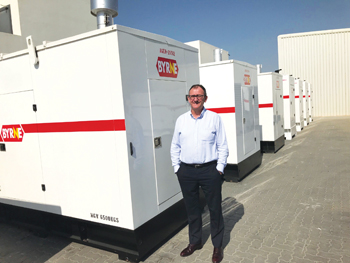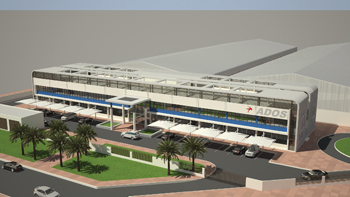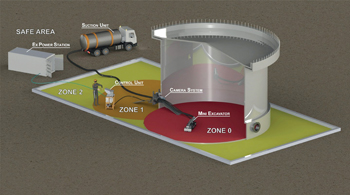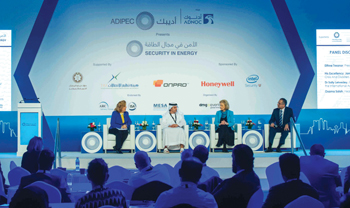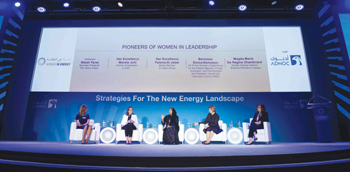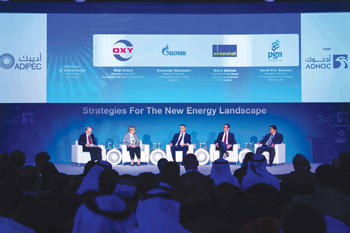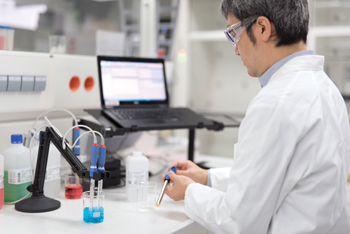
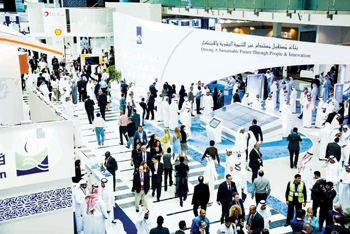 Adipec ... the most comprehensive petroleum industry event
Adipec ... the most comprehensive petroleum industry event
Adipec 2017 is at full capacity, covering 130,000 gross sq m of floor space with the participation of 20 national oil companies, including Saudi Aramco, the Kuwait Oil Company, the Chinese National Petroleum Corporation, Petronas and Lukoil
The Abu Dhabi International Petroleum Exhibition and Conference (Adipec 2017), taking place in Abu Dhabi from November 13 to 16, will be the convening power for the oil and gas industry, with the expected the participation of more than 2,200 exhibiting companies, and over 100,000 trade professionals, says Ali Khalifa Al Shamsi, CEO of Al Yasat Petroleum Operations Company and Adipec 2017 chairman.
"New for Adipec 2017 will be a conference programme and exhibition space for the downstream industry. This is part of our objective to create the most comprehensive petroleum industry event for senior decision makers and high-level professionals, and follows the successful introduction of the specialised Security in Energy programme and Offshore and Marine zone in recent editions. We are also adding more Global Business Leader sessions to the strategic conference programme, ensuring Adipec is an industry global knowledge exchange hub, at both strategic and technical levels," says Al Shamsi in an exclusive interview with OGN.
With sales made on the exhibition floor, and major investment deals discussed or signed among the CEO and VIP attendees, Adipec plays a direct role in many billions of dollars in business every year, he says. For 2016, more than $9-billion worth of contracts were signed over the course of four days.
Adipec is also a catalyst for diversifying the UAE economy, by creating new employment and business opportunities that drive the emirate’s socio-economic development, he says.
Al Shamsi says this year Adipec’s hallmark features return, bigger than ever, including the Conference Programme with more than 900 speakers sharing their industry knowledge and expertise across more than 185 conference sessions. These will include 4 Ministerial Sessions, 4 Global Business Leader Sessions, 8 Downstream Global Business Leader Sessions, 8 Panel Sessions, 8 Offshore & Marine Sessions, 8 Women in Energy Sessions, 14 Security in Energy Sessions, and 119 Technical Sessions, he says.
 |
Al Shamsi ... business worth billions of dollars being generated |
Confirmed headline speakers for the Opening Ceremony and Global Business Leader sessions include Dr Sultan Al Jaber, UAE Minister of State and Adnoc Group CEO; Lord Jim O’Neill, former Commercial Secretary, HM Treasury, UK Government, and also former Chief Economist, Goldman Sachs and creator of the BRICs acronym; Bob Dudley, group chief executive at BP; Datuk Zulkiflee W. Ariffin, president and Group CEO of Petronas; Patrick Pouyanné, chairman and CEO of Total; Vagit Alekperov, president, member of the Board of Directors, and chairman of the Management Committee, at Lukoil; Musabbeh Al Kaabi, CEO, Petroleum and Petrochemicals, at Mubadala Investment Company; Mario Mehren, chairman of the Board of Executive Directors, at Wintershall; Toshiaki Kitamura, president and CEO at Inpex Corporation; and Claudio Descalzi, CEO at Eni.
The exclusive VIP Programme also returns, inviting industry officials and decision makers to engage in open dialogue with members of the prestigious Middle East Petroleum Club (MEPC), the definitive networking and knowledge-exchange platform for senior oil and gas executives.
Excerpts from the interview:
How much floor space has been booked for Adipec 2017? How many countries are participating?
The event is at full capacity, covering 130,000 gross sq m of floor space. We will see the participation of 20 national oil companies, including Saudi Aramco, the Kuwait Oil Company, and the Chinese National Petroleum Corporation, Petronas, Lukoil and Gazprom, as well as 14 international oil companies, including ExxonMobil, Total, BP, and Shell.
We expect exhibitors from 53 countries, and will host 27 international pavilions this year, including those from major oil producing countries as well as major suppliers of technology, equipment and services. National pavilions include Azerbaijan, Belgium, Canada, China, Denmark, France, Germany, India, Indonesia, Italy, Japan, Kazakhstan, South Korea, Malaysia, the Netherlands, Norway, Pakistan, Russia, Saudi Arabia, Scotland, Serbia, Singapore, Spain, Turkey, the UK, Ukraine and the US.
What has prompted Adipec to include the downstream sector this time?
It is part of our objective to offer a complete and comprehensive programme of opportunities for senior petroleum industry decision makers and skilled professionals. It follows successful previous additions to the event, such as the dedicated security and offshore programmes.
Downstream industries are an increasingly important strategic focus for Adipec’s major NOC and IOC partners, many of which are expanding their activities across the full value chain from exploration and production, through various forms of refining and processing, to marketing the final product. Adipec recognises this and is committed to supporting strategic investments and enabling new partnerships across the full value chain.
How big will the expanded technical programme be?
The technical conference will include 119 technical sessions, with presentations across many professional industry areas. These include E&P Geoscience; Project Management and Engineering; Gas Technology; Field Development; Unconventional Resources; Production Facilities Technologies; Petroleum Advanced Analytics; Operational Excellence; Drilling and Completion Technology; Improved Oil Recovery and Enhanced Oil Recovery; Health, Safety and Environment; People and Talent; and Offshore and Marine.
 |
An Adipec conference in session |
We also have 8 technical industry panel sessions, offering a broader discussion of topics, with an emphasis on the challenges of change, both in the market and in the technology available to increase efficiencies, optimise costs and enhance performance.
We received 3,060 abstract submissions from 622 organisations, located in 70 countries, for the technical conference stream. That sets a record for Adipec, and is a 10 per cent increase from last year, and more than 50 per cent growth since 2015. From these, the Adipec 2017 technical committee, comprised of 164 industry leading experts, selected 809 high-quality abstracts to be presented during the conference.
What are the key features of the Global Business Leader panels in this edition of Adipec?
Building on the previous success of the Global Business Leaders panels, we have expanded these to four sessions for 2017 one more than in 2016. We will also have four dedicated Downstream Global Business Leader panels.
The panels are a unique opportunity for conference delegates to hear insights from some of the more than 20 very senior oil and gas executives. The on-stage conversations will explore aspects of growth, partnership, leadership, and economics, from a top-level strategic perspective, and with consideration to current challenges for the industry.
‘Forging Ties, Driving Growth’ is the theme for Adipec 2017. Could you reflect on why this theme was chosen?
The theme represents the spirit of partnership and opportunity that is the foundation of Adipec. It underlines Adipec’s status as a platform for creating new business opportunities and for sharing knowledge, experience and ideas that will drive future development of the oil and gas industry.
It also represents the importance of Adipec as a global hub for oil and gas, where the industry’s most powerful decision makers meet, and where the discussions held, both in public forums and in personal conversations, will have a direct impact on the strategic direction of many of the leading NOCs and IOCs.
What are the main challenges and opportunities in the Middle East’s oil and gas industry in general, and the UAE in particular?
We continue to experience prices that are at a much lower level than in the years prior to 2014, but we have seen modest increases and stability in the past year, and looking ahead we expect rising demand will support further price recovery.
The oil and gas industry is adapting to meet its challenges. In the past three years, our industry has achieved greater efficiencies, optimised costs and utilised resources more effectively. As a result, companies are returning to a more expansionary investment position. Future investments will be smart, will emphasise efficiency, and they will prioritise diversification and vertical integration. This can be seen in the pivot towards downstream investments by many NOCs, as they aim to create value from their resources at each stage of the value chain.
In the longer term, oil and gas companies must prepare for the motor industry to transition away from hydrocarbons as a fuel source, with many countries making firm commitments to phase out petrol and diesel cars. Nevertheless, oil will continue to have other important uses, as a fuel for heavy transport and aviation, as well as in the production of petrochemicals. However, we do need to consider how any rebalancing of the energy mix away from fossil fuels will affect our business model, and begin to adapt accordingly.
Several oil companies are already diversifying their operations to become energy companies in a broader sense, investing in renewables as well as hydrocarbons. There are also significant new opportunities for natural gas, which is seeing rapid growth in demand as a cleaner fuel for electricity generation, alongside renewables.
What does the UAE stand to gain by hosting Adipec year after year?
Adipec attracts business to Abu Dhabi and the UAE, and to the broader Gulf region and Middle East. An event of this scale and importance contributes to the UAE’s future as a strategic economic centre, and as an international crossroads for global trade, where east, west, north and south all meet.
We offer petroleum industry business leaders and technical experts – the people who guide the future of the industry – a shared platform that contributes to the growth and development of their business. This in turn establishes Abu Dhabi and the UAE as a global energy hub, and by extension, as a global hub for other business, and for trade and finance across many sectors.
How much worth of business was generated at Adipec 2016? What are your projections for this year?
In your opinion, what benefits do the Adipec conference bring to the global oil and gas dialogue?
We create a dialogue that not only impacts day-to-day operations but also corporate strategy at every level of the oil gas industry, making a real contribution to the industry’s future development and resilience. Adipec enables conversation among those whose decisions make a difference in the market. If you are not here, it means you are not part of the conversation.
No other event can match Adipec for either the scale or range of industry knowledge exchange. We host more than 185 conference sessions, across both the strategic and technical programmes, and bring together more than 10,000 delegates, whose roles cut across professional boundaries. That’s the formal conference component. When you consider informal networking, we are also the only annual event where top CEOs can be sure that they will meet their counterparts from a wide grouping of their main competitors, suppliers, partners or customers, in the same city at the same time.
In its fifth year, what has been the response to the Young Adipec initiative?
Young Adipec continues to grow. We have now hosted around 1,500 high school students as part of the programme, and after four successful years we can see that it is helping young Emiratis discovery their career path. It is particularly satisfying to see that most participants in Young Adipec are female, and many are encouraged to pursue careers in fields such as geoscience and engineering.
For the Young Adipec Forum this year, we have some of our original group from 2013 returning to share their stories, each of them describing how Young Adipec helped guide their study choices for university. In the future we can expect to see former participants attend Adipec as professionals employed in the oil and gas industry.
How many exhibitors are expected at this year’s Adipec Offshore and Marine Zone, and what has been the response to this area been?
Adipec’s Offshore and Marine display is expected to grow to more than 150 exhibitors for its third edition, and attract around 15,000 visitors.
The response to this landmark feature has been extremely positive, particularly to the unique waterfront location which allows the display of large marine vessels moored alongside the purpose-built exhibition hall. This innovative concept means exhibitors can display everything from rigs, vessels, and subsea drilling equipment, pipelines, and associated tools, equipment and technology for offshore exploration and production.
For 2017, we have expanded the conference programme tailored to offshore and marine professionals to eight sessions, including plenary panel discussions, and featuring leading industry figures addressing growth, future expectations and challenges in subsea, offshore structures, rigs, vessels and workboats.
What role has the Women in Energy conference played to address the issue of gender equality in oil and gas jobs?
Women in Energy provides a vital platform enabling women and men from many countries to meet, network and share experiences. As an industry, we have achieved significant success in bringing more women into the oil and gas industry, particularly in business administration and management roles. The challenge now is to achieve similar success for technical roles. We are seeing many female students choose to study in highly technical fields.




































































